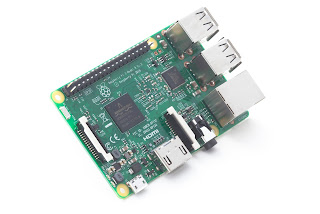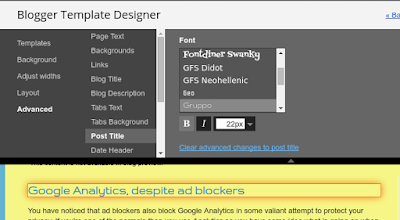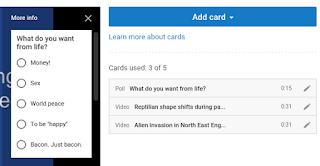- Switch off the monitor.
- Allow the computer to put the graphics card to sleep.
- Simultaneously switch the monitor back on and wake the computer.
Search This Blog
The Ghost in the Machine
Raspberry Pi 3 on sale now
RASPBERRY PI 3 ON SALE NOW AT $35
In celebration of our fourth birthday, we thought it would be fun to release something new. Accordingly, Raspberry Pi 3 is now on sale for $35 (the same price as the existing Raspberry Pi 2), featuring:
- A 1.2GHz 64-bit quad-core ARM Cortex-A53 CPU (~10x the performance of Raspberry Pi 1)
- Integrated 802.11n wireless LAN and Bluetooth 4.1
- Complete compatibility with Raspberry Pi 1 and 2
BCM2837, BCM43438 AND RASPBERRY PI 3
For Raspberry Pi 3, Broadcom have supported us with a new SoC, BCM2837. This retains the same basic architecture as its predecessors BCM2835 and BCM2836, so all those projects and tutorials which rely on the precise details of the Raspberry Pi hardware will continue to work. The 900MHz 32-bit quad-core ARM Cortex-A7 CPU complex has been replaced by a custom-hardened 1.2GHz 64-bit quad-core ARM Cortex-A53. Combining a 33% increase in clock speed with various architectural enhancements, this provides a 50-60% increase in performance in 32-bit mode versus Raspberry Pi 2, or roughly a factor of ten over the original Raspberry Pi.
James Adams spent the second half of 2015 designing a series of prototypes, incorporating BCM2837 alongside the BCM43438 wireless “combo” chip. He was able to fit the wireless functionality into very nearly the same form-factor as the Raspberry Pi 1 Model B+ and Raspberry Pi 2 Model B; the only change is to the position of the LEDs, which have moved to the other side of the SD card socket to make room for the antenna. Roger Thornton ran the extensive (and expensive) wireless conformance campaign, allowing us to launch in almost all countries simultaneously. Phil Elwell developed the wireless LAN and Bluetooth software.
All of the connectors are in the same place and have the same functionality, and the board can still be run from a 5V micro-USB power adapter. This time round, we’re recommending a 2.5A adapter if you want to connect power-hungry USB devices to the Raspberry Pi.
You’ll need a recent NOOBS or Raspbian image from our downloads page. At launch, we are using the same 32-bit Raspbian userland that we use on other Raspberry Pi devices; over the next few months we will investigate whether there is value in moving to 64-bit mode.
Blogger Template Designer does not apply web font selections
...except that it doesn't work properly.
Why?
Well, it would appear that when you open the BTD it nicely downloads all the web fonts so that you can preview them easily. The problem is that once you have made your selection the only part of the template code that is changed is the font name. There is nothing to instruct the browser that it needs to download the font in order to render it. Sadly, you will have to faff around with the template code.
The first thing to do is to find the font you wanted over at Google Fonts. In my case it is Gruppo: https://www.google.com/fonts/specimen/Gruppo. There should be a link that takes you into Google Fonts where you can play around with the fonts of your choice, and the styles of your choice. The buttons along the bottom will take you to a page that shows you what code you need to add to your page. In my case this was:
<link href='https://fonts.googleapis.com/css?family=Gruppo' rel='stylesheet' type='text/css' />And now your selection should work. The BTD should have inserted enough into the template at this point to allow the browser to render your font correctly. If not... 😕.
Note: Things may not work nicely in Internet Explorer. That's tough luck - don't use Internet Explorer.
Google Analytics, despite ad blockers
You therefore need a way of tracking what is going on.
First, let's have a quick look at what is going on with the Analytics code.
Once you have created your property, you are told to add a code snippet to your pages:
(function(i,s,o,g,r,a,m){i['GoogleAnalyticsObject']=r;i[r]=i[r]||function(){(i[r].q=i[r].q||[]).push(arguments)},i[r].l=1*new Date();a=s.createElement(o),m=s.getElementsByTagName(o)[0];a.async=1;a.src=g;m.parentNode.insertBefore(a,m)})(window,document,'script','https://www.google-analytics.com/analytics.js','ga');
ga('create','UA-12345678-90','auto');
ga('send','pageview');/usr/bin/env: node: No such file or directory
The Problem
You have installed npm or nodejs and the second you go to use it you receive an error message:
/usr/bin/env: node: No such file or directoryThe Cause
Package managers. *sigh* What is normally named node is named nodejs.
$ which nodejs
/usr/bin/nodejsThe Solution
[ -d ~/bin ] || mkdir ~/bin
ln -s $(which nodejs) ~/bin/nodeThis will allow your system to find node.
There must be some reason behind the package maintainers renaming node to nodejs, probably to avoid a conflict, so you don't really want to be renaming files, or making the changes system-wide (
/usr/local/bin) unless you know what you are doing.$ node --help
Usage: node [options] [ -e script | script.js ] [arguments]
node debug script.js [arguments]
Options:
-v, --version print node's version
-e, --eval script evaluate script
-p, --print evaluate script and print result
-i, --interactive always enter the REPL even if stdin
does not appear to be a terminal
--no-deprecation silence deprecation warnings
--trace-deprecation show stack traces on deprecations
--v8-options print v8 command line options
--max-stack-size=val set max v8 stack size (bytes)
Environment variables:
NODE_PATH ':'-separated list of directories
prefixed to the module search path.
NODE_MODULE_CONTEXTS Set to 1 to load modules in their own
global contexts.
NODE_DISABLE_COLORS Set to 1 to disable colors in the REPL
Documentation can be found at http://nodejs.org/Great stuff!
References:
https://github.com/nodejs/node-v0.x-archive/issues/3911#issuecomment-8956154
YouTube Poll Cards are git lush, honest!
Everyone loves polls. It's just a fact. YouTube know this so they have introduced Poll Cards to creators.

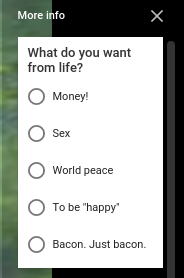
Cards are interactive elements that slide into view during a YouTube video which prompts a user to interact in one of a number of ways. You can use a Card to:
- Promote a video or playlist
- Promote a channel
- Ask users to take part in a poll
- Link to an approved website
- Ask users to donate to a non-profit
- Beg for money
Unless you're using an overbearing adblock, you'll see them in the video that you're watching.
This, of course, allows users to give you quick feedback where they might not be able to use the comments section, such as when the video is embedded into another site or a third-party application, assuming the application can handle them; or if they just can't be bothered to scroll down a bit. It offers the user an easy way to interact.
The cards can be updated at any time to ask a different set of questions. The video, of course, cannot without uploading a whole new video, bar simple editing like video quality. If you add your own comment asking questions it could be buried under the avalanche of xenophobic bilge that always fills a YouTube comments thread. This way your question will be seen.
You can change your answer too, should you choose the wrong option the first time.
If you're a creator in good standing it is incredibly easy to add a Poll Card.
From your My Videos click on the drop-down menu next to the video you want to add a card to and select Cards.
Once you're in there, pick the position of the video where you want your teaser to appear then click Add card. From there you can select Poll and fill in the details. It is a very simple interface: there's no room for confusion.
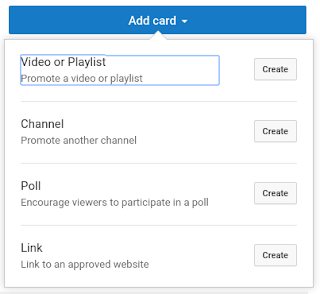

Click Save and it's done! You can click on the little i to see your new Poll card. Lush.
New frontiers in communication systems
New research by the universities of Bristol, Keio and industrial partners have unlocked 80 THz of fibre-optic bandwidth that will enable future exascale data centres and transform 5G networks.
The research on optical communication technologies, wavelength division multiplexing and networks form the backbone of every wired network across the whole Internet. Work until now has been focused and limited on utilizing ~11 THz of bandwidth (C and L Band) centred at 193 THz.
Optical networks based on this frequency bands have been able to support up to 230 channels at 50 GHz spacing.
The technology fabricated and tested is based on cascaded arrayed waveguide gratings (AWGs) and is designed to potentially construct a 1600 x 1600 wavelength router that can guide data at the speed of light. Specially designed quantum dot chips are used for light sources.
This single passive optical system can route immense information offering manifold increase from current systems. It can single-handedly interconnect over one million end points while offering at least ten Gb/s per end point. Critically it is also future proof since it's transparent to any communication signal and it can also potentially consume zero power due to its passive nature.
Read the full article at New frontiers in communication systems.
YouTube's "Remove a Song" - Wow!
Anyone else who has found their way here might be familiar with the copyright claims being slapped on their own videos, and how annoying that can be.
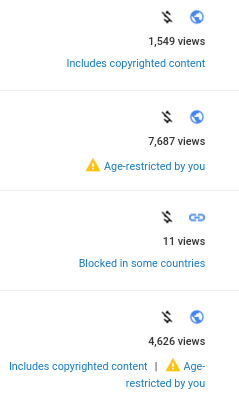
Copyright claims can have the following effects:
- You are unable to monetise your video, or have to share the monetisation with the claimant.
- You are forced to have adverts show on your videos when you don't want them.
- You may struggle to upgrade your channel to include certain features, such as live broadcasts.
- Your video(s) may be blocked altogether in certain regions.
To my delight and amazement I discovered that a fair bit of work has gone into solving the issue:

Could it be that easy?

Certainly looks like it!
YouTube have, rather quietly, introduced this "Remove a Song" tool to remove the music from your videos without affecting the rest of the audio.
So now we just hit "Save" and let the gremlins cast their magic.

And when the processing is finished...
Success! Well, almost. One video failed.
But let's not forget what has happened here: YouTube have managed to remove the music from the video without affecting the rest of the audio. It's very impressive and not something I would know how to do myself. My planned solution was to simply mute parts of the track, but now that isn't necessary. Yes, one failed, but the service is still in beta. Hopefully this will be one of the features that remains on YouTube. Some other features have quietly come and gone with time.
Of course if you want to do covers of songs then removing the music probably isn't an option. But that's up to you. In that case you may be able to share the advertising revenue, or simply be given permission from the copyright owner.
My videos no longer have copyright claims against them. Hurrah!
Update: YouTube does NOT listen to copyright claims
I have had to do a lot of research on this damned problem to fight the copyright claims on my videos, which I really shouldn't have to do. They don't even receive that many hits but the lack of response pissed me off. I think I have found an answer on how these wallies came to their conclusion.
On the 12th of September, 2011, the Council of Europe adopted Directive 2011/77/EU, which in accordance with Article 4 came into force on the 20th of the same month. The Directive recommends extending protection of the rights of performers and phonogram producers on music recordings within the EU from 50 to 70 years; the exact details vary and can be gleaned from the text of the Directive, as well as some other protections and recommendations.
This is somewhat crucial to my story: my video, Sunderland Airshow 2012, was of course recorded in 2012, which was seven years after the expiration of the copyright, under the old rules, on The Dam Busters March, which appears in the video. Presumably this was overlooked by the original claimant in my story.
The general idea behind the Directive is that recording artists aren't paid for long enough for their work and they should be paid for even longer. The texts leading up to, and included in, the Directive suggest that this will help poorer performers receive adequate compensation for their work, whereas nobody really cares how hard-up the millionaires think that they are. The E.U. have, at times, been criticised for making some rather ridiculous suggestions and recommendations, some of which end up being law. I'll let you decide if this one is a sensible one or not....
....I digress.
The Directive wouldn't have affected me at all if it was not applied retroactively. From the rather in-depth Impact Assessment:
It appears that a partially retro-active extension, with a specific cut off date, would be the simplest solution as regards the legal and administrative aspects and would bring the most benefit to right holders from the start.The Impact Assessment explains what it means by the term partially retro-active but it could be inferred that I am affected by this.
I certainly don't know enough about law to give any kind of in-depth analysis of what this all means, but I did wonder if this did not violate Article 7 of the European Convention on Human Rights (codified in U.K. law under the Human Rights Act 1998):
No one shall be held guilty of any criminal offence on account of any act or omission which did not constitute a criminal offence under national or international law at the time when it was committed.I would suggest that the E.C.H.R. only applies to government bodies, though there have been a number of high-profile cases in the U.K. in which the E.C.H.R. has been deemed to apply to businesses (mainly the press). Crucially, though, Article 7 states that it applies to criminal offences, and any legal matters arising from my circumstances would almost definitely fall under civil law. Indeed, there was no criminal act or intent (not on my behalf anyway).
So there we go. Not very technical but it almost concludes the story so I thought I should share.
Now if only there were some way to remove the musical composition from the audio track of my video....
References:
- http://ec.europa.eu/internal_market/copyright/docs/term/ia_term_en.pdf
- http://europa.eu/rapid/press-release_PRES-11-303_en.htm
- http://eur-lex.europa.eu/LexUriServ/LexUriServ.do?uri=OJ:L:2011:265:0001:0005:EN:PDF
Aside:

